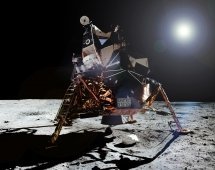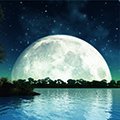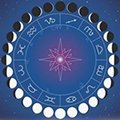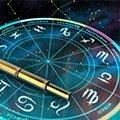The first flight to the moon
If in the space race of the USSR the USA was ahead, then they headed the lunar race. But initially in the lunar race the USSR was the leader. The first device that flew alongside the Moon was the Soviet automatic interplanetary station "Luna-1", this happened on January 2, 1959, and the first device reaching the Moon was the "Luna-2" station on September 13, 1959.
After numerous successes of the USSR in space exploration, the US decided to regain the status of the most technologically advanced power and focused on the Moon. In 1961, they announced the lunar manned program "Saturn" - "Apollo", aimed at reaching the moon by a man before the end of the decade of the 1960s.
President Kennedy even made a proposal for a joint landing program for the moon (and also for the launch of more advanced meteorological satellites), but in the USSR he was refused because he suspected a trick. However, the lunar manned program in the USSR was approved only in 1964, when the US was doing it in full swing. In the USSR, large-scale work on two parallel manned programs was launched: the flight of the Moon (Proton-Zond / L1) by 1967 and landing on it (H1-L3) by 1968. Previous unmanned flights of the ships "Zond (7K-L1) "was completely or partially unsuccessful due to defects in the ship and carrier.
In December 1968, America pulled ahead and won the first (flying) stage of the lunar race, when Frank Borman, James Lovell and William Anders in the flight on December 21-27 on the ship Apollo-8 made 10 turns around the moon. Less than a year later, with the implementation of the second (landing) stage, the United States, the whole lunar race.
Flight "Apollo 11"
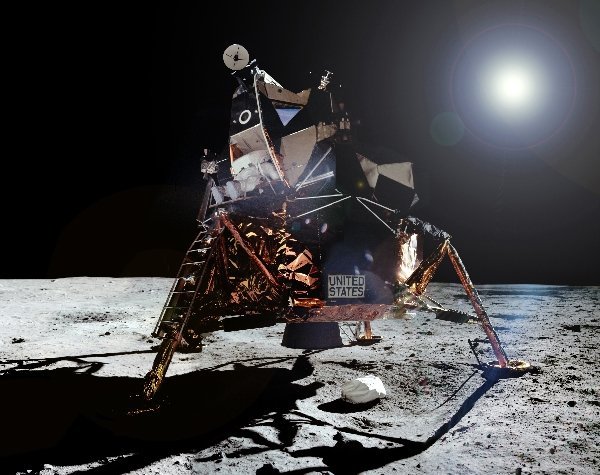
July 16, 1969 from Cape Canaveral launched the American ship "Apollo 11" with a crew of three people: Neil Armstrong, Michael Collins and Edwin, E. Aldrin, Jr .. July 20 was the landing on the moon, and on July 21 Neil Armstrong made an exit to the surface of the moon. All over the world, with the exception of the USSR and the PRC, there was a live broadcast of about 500 million people watched this event. Subsequently, the USA conducted 5 more successful expeditions to the Moon, including several dozen kilograms of lunar soil in each voyage.
July 20, 1969, at 20:17:39 UTC (World Coordinated Time - the standard by which society regulates time and time), crew commander Neil Armstrong and pilot Edwin Aldrin planted the lunar module of the ship in the south-west area The Sea of Tranquility. They stayed on the surface for the moon for 21 hours and 36 minutes. All this time, the pilot of the command module, Michael Collins, was waiting for them in a near-moon orbit. The astronauts made one to the lunar surface and were there for 2 hours and 31 minutes. The first person to step on the moon was Neil Armstrong. After 15 minutes, Aldrin joined him. This happened on July 21 at 02:56:15 UTC.
All the crew members were experienced pilots, all three-one-year-olds, born in 1930.
Preparation for flight
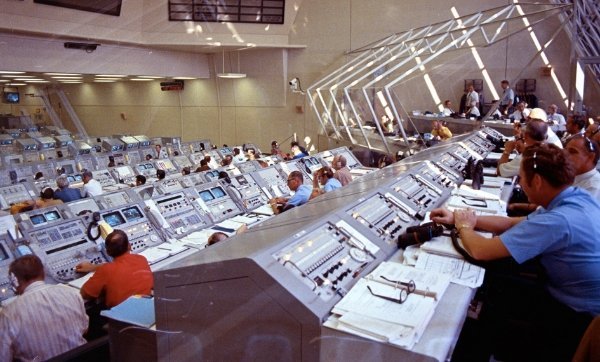
The most careful way was practiced landing on the moon. Astronauts practiced on the model of the lunar module, which was suspended to a tall tower-crane on the cables. There were more advanced simulators - flying machines for working out lunar landings. They were a frame made of aluminum pipes, on which were attached three main and 16 shunting engines and a control cabin. One of the main engines raised in the device to the required altitude (up to 1.8 km) and then during the descent and soft landing . Astronauts called them the "flying skeletons of beds." In May 1968, as commander of the backup crew of Apollo-8, Neil Armstrong nearly crashed. The device went out of control, and Armstrong had to be catapulted from the 60-meter height, he got off with light bruises. The device crashed and burnt.
In recent months, before the start, the astronauts have been practicing a lot: the way to the lunar surface was imitated in full equipment, the soil samples were collected and scientific instruments and experiments were installed Houston), several practical field exercises took place on geology.
The crew also developed the design of the emblem and the choice of callsigns for ships (see the picture in the preamble). The astronauts wanted to make the very simple and unambiguous, showing the peaceful conquest of the moon. James Lovell proposed to depict an eagle. Michael Collins made a drawing. On it an eagle, holding an olive branch in its beak, sits on the lunar surface. Behind him is the Earth, in the distance and above the inscription "Apollo 11". The name of the astronauts on the emblem was not. But when the emblem was presented to NASA headquarters, the management did not know the claws of the eagle. Callsigns in this. The name of the lunar module is "Eagle", and the command one is "Columbia".
We also worked on one more problem. Astrobiologists and experts from the US Public Health Service feared that landing people on the moon could lead to the introduction of unknown microorganisms that could cause epidemics to the Earth. Despite the fact that many scientists were sure that the Moon was lifeless, there was absolutely no certainty about it. Therefore, the task was to develop a plan to prevent biological contamination of the Earth. Measures were also developed for the stage of transportation of astronauts and containers with samples of lunar soil from the place of excavation in the Pacific to the Lunar Reception Laboratory. They are provided that they are transferred from the command module to the inflatable boat, they immediately put on the biological protection of the helicopter to go to a special mobile hermetic van without wheels, in which they are delivered to Houston. Two weeks before the start, the chief doctor of the Apollo, the reduced burden of training on astronauts and placed them in quarantine.
Before the flight, an unprecedented boom was created: 500,000 tourists who wanted to witness the historic event arrived in the County of Brevard in Florida, where there are Cape Canaveral and the Kennedy Space Center.
Start

The launch of Apollo 11 took place on July 16, 1969 at 13:32 UTC. There were 5,000 guests of honor, including the 36th US President Lyndon Johnson. During the take-off, applause was heard, but most of the audience watched silently, while "Apollo 11" did not disappear from sight. The takeoff was directly broadcasted on television in 33 countries around the world on 6 continents. After takeoff, US President Richard Nixon announced the following Monday, when astronauts were supposed to be on the moon, the National Participation Day and a non-working day for civil servants.
Flight
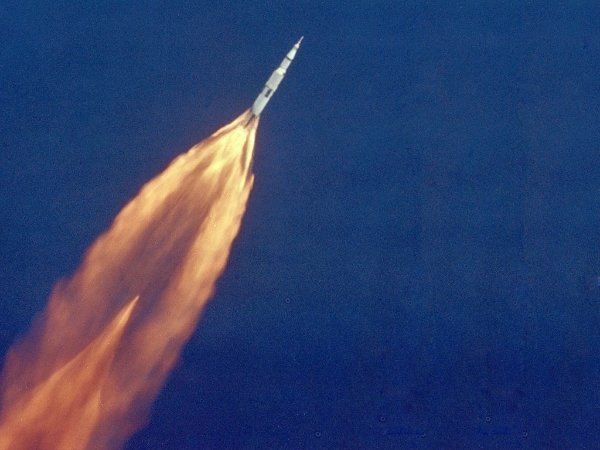
When the spacecraft entered a circular near-earth orbit with the height of 190.8 km, the third stage engine was switched on for 5 minutes and 47 seconds. "Apollo 11" reached the second space speed (10.84 km / s) and switched to the flight path to the Moon. Astronauts began the maneuver of the rebuilding compartments, docking with the lunar module and "pulling" it out of the adapter, located at the top of the third stage. The command and service module was separated from the third stage. Then Michael Collins made a rapprochement and docking with the lunar module. When Columbia and the Eagle retreated to a safe distance, the third-stage engine turned out to be the last one on the Earth. At the suggestion of Armstrong, the first unplanned TV broadcast was conducted from the ship's side. The color on-board TV camera gave an image of good quality. The broadcast lasted a little more than 16 minutes. The distance from the Earth was about 95,000 km. The sun was illuminated by 7/8 of the earth's disk, and the eastern part of the Pacific Ocean, the greater part of the USA, Mexico, Central America and the northern part of South America were precisely visible. The astronauts transferred the ship to passive thermal control mode, when it was slowly rotated about its longitudinal axis, making about three turns in 1 hour. This ensured a uniform heating of the ship's skin. On the third day of the flight Armstrong and Aldrin first switched to the lunar module and checked the state of its main systems. On the fourth day, the astronauts entered the near-moon orbit.
Landing on the Moon
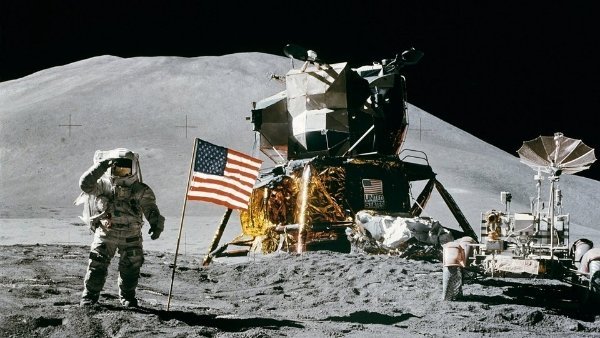
On July 20 Neil Armstrong and Edwin Aldrin moved to the lunar module, activated and tested all of its systems. At a height of just under 2 km, the approach to the landing site began. At an altitude of about 140 meters, the commander carried the computer to a semi-automatic mode in which the landing stage is motorized controlled manually. And 20:17:39 UTC Aldrin shouted: "Signal contact!" A blue contact signal meant that at least one of the 1.73 m long probes touched the moon's surface, which were attached to three of the four pillars (except the one where there was a ladder). In 1.5 seconds after that, Armstrong muffled the engine. In the post-poll, he said he could not pinpoint the time of landing. According to him, Buzz shouted: "Contact!", But he himself did not even see the lighted signal, the engine worked until the landing, because it was so soft that the time determine.
On the moon
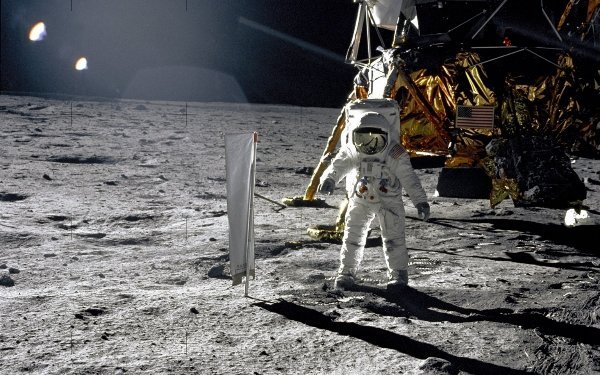
During the first two hours of the Moon, Neil Armstrong and Edwin Aldrin were engaged in simulating pre-launch preparations in the case there was a need for early termination of a stay on the Moon for some reason. The astronauts looked at the portholes and told Houston about their first impressions.
Before going to the moon, Aldrin, as the elder of the Presbyterian Church, held a brief private church service, having performed the Eucharist (translated from Greek as "thanksgiving"). Holy Communion is a Christian rite, consisting in the consecration of bread and wine in a special status and their subsequent eating.
With his right hand on the ladder, Armstrong stepped on the lunar surface with his left foot and said: "This is one small step for man, but a giant leap for all of humanity." Still holding on to the ladder, Armstrong stepped on the ground and his right foot. According to him, the small particles of the ground were like a powder, which can be easily thrown up. They are adhered thinly to the soles and sides of the moon shoes, like crushed charcoal. Legs drowned in it quite a bit, not more than 0.3 cm. But Armstrong could see his tracks on the surface. The astronaut said that it is not difficult to move on the Moon, in fact it is even simpler than during imitations of Earth. According to Armstrong's observations, the landing stage engine did not leave any crater on the surface. Aldrin handed the camera to Armstrong, and he began to shoot the first lunar panorama. Houston was reminded of him of an emergency accident of the lunar soil (in the case of the stay on the Moon). Armstrong collected it with a special device that looked like a small net, and put it in the pouch in the hip pocket of the suit. The mass of the emergency sample was 1015.29 g. It consists of regolith and four small stones of about 50 g each. 15 minutes after Armstrong made the first step on the Moon, Aldrin started to go down from the cab. They photographed the surroundings of the landing site, Aldrin placed the screen of the solar wind collector (he was a sheet of aluminum foil, 30 cm wide and 140 cm long and was designed to trap helium, neon and argon ions.) Both astronauts then installed the US flag.
While Armstrong was preparing tools to collect samples of lunar soil, Aldrin tried various methods of movement. He said that jumps with simultaneous repulsion by the two legs, like kangaroos, are getting good, but to move forward the traditional way is still preferable.
Collecting soil samples, astronauts, the setting of a set of scientific instruments: a passive seismometer and a corner reflector for the laser location of the Moon.
They spent the night on the Moon, in the cockpit of the module in spacesuits, helmets and gloves, to breathe pure oxygen, and not lunar dust (inside the lunar module everything was very dirty). The curtains on the portholes turned out to be quite the opaque, the horizon was visible through the telescope of the optical sight. In addition, the cab was 16, and the astronauts were freezing, so they did not get to sleep.
Rise from the Moon
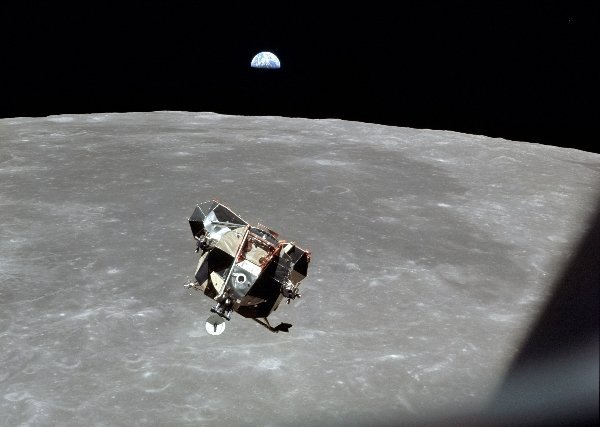
After the ascent, the astronauts began to prepare for take-off. They stayed on the Moon for a total of 21 hours 36 minutes 21 seconds. The first 10 seconds "Eagle" climbed strictly vertically. After 7 minutes, "Eagle" entered the intermediate orbit. Approximately an hour after takeoff, when both ships were on the other side of the Moon, Armstrong turned on the engines of the orientation system. The lunar module moved to an almost circular orbit. As a result of several consecutive maneuvers, three and a half hours after takeoff, the Oryol and Columbia converged to a distance of 30 m and remained motionless relative to each other. Then Collins made the final rapprochement and docking. Then he puffed up the tunnel, opened the hatch, and passed the vacuum cleaner to Armstrong and Aldrin. They, as far as possible, cleaned the spaceships and everything that was transferred to the command module. Collins became the third person to see the lunar soil. Armstrong, without opening it, showed him the packet with emergency specimens. Soon after Armstrong and Aldrin moved into the command module, the take-off stage of the Eagle was dropped. She stayed in orbit, but eventually had to fall to the moon. Collins 7-second turn on the engines of the orientation system took "Columbia" to a safe distance. When the maneuver was completed, Armstrong and Aldrin removed their spaceships that had been worn on them from the previous day. On July 24, the ship wrecked 3 km from the calculated point and 24 km from the Hornet aircraft carrier.
Moon ground
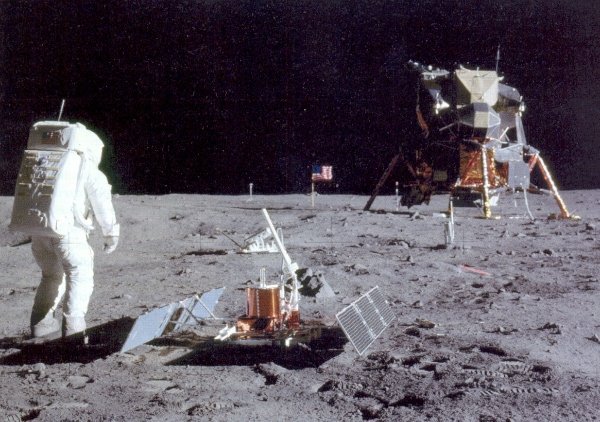
Containers with samples were double sterilized: first with ultraviolet rays, then with special acid. Then they were rinsed with sterile water and dried with nitrogen, and then through a vacuum lock, they were placed in a vacuum zone. In the afternoon of July 26, the first container was opened. Photographing, cataloging and preliminary study of lunar soil.
Astronauts were supposed to be in the quarantine for 21 days. No pathogens or symptoms of infectious disease were found by either of astronauts or from anyone who was with them in quarantine, so it was decided to stop the quarantine one day earlier than planned.
Samples of the lunar rock should be stayed longer in the Lunar Laboratory, from 50 to 80 days, until the results of all crops for microorganisms are ready. Several hundred grams of regolith and chipped lunar stones became a material for determining their toxicity and pathogenicity. The lunar material was tested on sterile mice and various plants. No case that could indicate a danger to terrestrial organisms was noted, only a few minor deviations from the norm. For example, it was found that samples of lunar rock stimulated the growth of some plants. It was concluded that the lunar soil is biologically safe. At noon on September 12, the quarantine was terminated. The study of the supplied samples in laboratories around the world. The first exposition of lunar stones and regolith for the general public was opened on September 17, 1969 at the Smithsonian Institution in Washington.
Scientific results
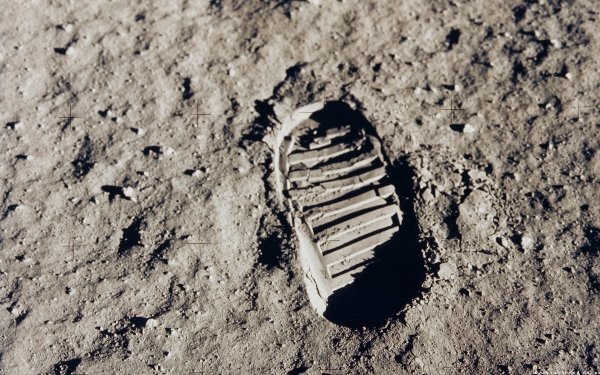
The first conference on the study of the moon was opened on January 5, 1970 in Houston. It was attended by several hundred scientists, including all 142 main researchers who received from NASA samples of lunar soil. The properties of the lunar rock indicate that it was formed at high temperatures, in the absence of oxygen and water. There were identified 20 minerals known on Earth, which spoke in favor of a single source of origin for both celestial bodies. At the same time, three new minerals were found on Earth. One of them was called armcolkolite (by the first letters of the names of astronauts). The age of the lunar samples was not the same. Basalts from the area of the Tranquility Base were 3-4 billion years old, while in the ground, there were particles that could have formed 4.6 billion years ago. This indicated that the surface of the Moon was formed by more than one catastrophic event. Samples taken from depth. At the same time, the study of isotopes formed as a result of cosmic-ray bombardment revealed that samples were carried by astronauts were on or in close proximity to the surface of the Moon for at least the last 10 million years. The chemical composition of the lunar basalts was different from the terrestrial ones. They had less volatile elements (sodium), but much more titanium. Surprising for scientists was the almost complete absence of lunar basalts of such a rare earth element as europium. The search for possible traces of life was futile. Carbon and some of its compounds were discovered, but no molecules that could be identified. An intensive search for living or fossil microorganisms.
Thus, the preliminary results of the study of lunar rocks brought to Earth. The problem of the origin of the moon was not solved. It became clear that the surface of the Moon is heterogeneous in composition and age, and that it is necessary to extract and study different regions.
Share:
Interesting articles:
- • The Origin of the Moon
- • The moon - the reverse side: riddles and secrets
- • Phases of the Moon, internal structure, surface



